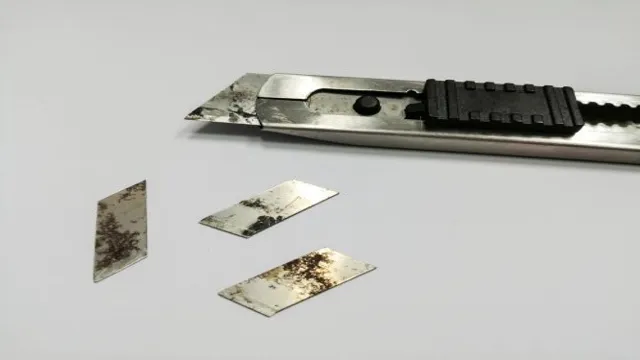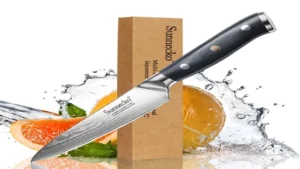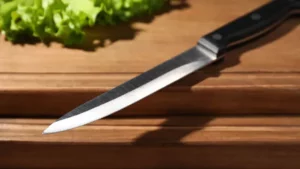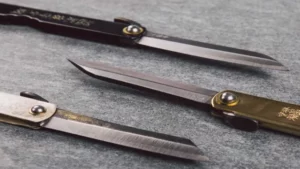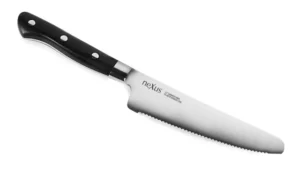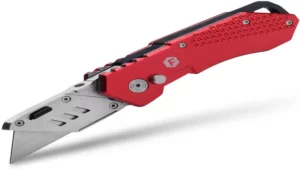Have you ever found yourself with a pile of used utility knife blades and were unsure of how to dispose of them properly? It’s a question that’s often overlooked, yet it’s important to know as these blades can pose a potential hazard if not disposed of correctly. Whether you’re using a utility knife for crafting, construction, or daily tasks, knowing how to dispose of the blades safely is crucial to ensure the safety of yourself and those around you. In this blog post, we’ll cover various ways to dispose of utility knife blades and the precautions you should take to avoid any accidents or injuries.
So let’s get started and learn how to properly dispose of utility knife blades!
Why You Should Dispose of Utility Knife Blades Safely
When it comes to disposing of utility knife blades, it’s essential to do so safely. These blades may seem small and insignificant, but they can be incredibly sharp and dangerous, posing a risk not only to yourself but also to those who come into contact with them. One of the best ways to dispose of them is by using a blade disposal box that’s designed specifically for this purpose.
These boxes are easy to use, and you can purchase them at most hardware stores or online. Simply place the used blades inside, and the box will safely contain them until it’s time to dispose of them properly. It’s also essential to never throw utility knife blades in the trash or recycling bin, as this can put others at risk.
By taking the time to dispose of these blades safely, you’re not only protecting yourself, but you’re also doing your part to keep those around you safe and secure.
Preventing Accidents
Utility knife blades are commonly found in almost every household and are often used for various purposes, such as opening boxes, cutting ropes, or slicing food. However, these blades can pose a significant risk if not disposed of properly. When a blade becomes dull or damaged, it is crucial to dispose of it safely to prevent accidents.
Leaving the blade lying around can lead to someone accidentally stepping on it or getting cut when trying to pick it up. It is also essential to dispose of the blade in a way that it does not harm the environment. Simply tossing the blade into the trash can be dangerous to sanitation workers or can lead to the blade ending up in a landfill, where it can cause problems for years to come.
Therefore, it is advisable to wrap the blade in paper or tape and dispose of it in a designated blade disposal container. This method ensures that the blade remains enclosed and out of harm’s way. By taking the necessary precautions, we can prevent accidents and make sure that the blade does not become a hazardous waste item.
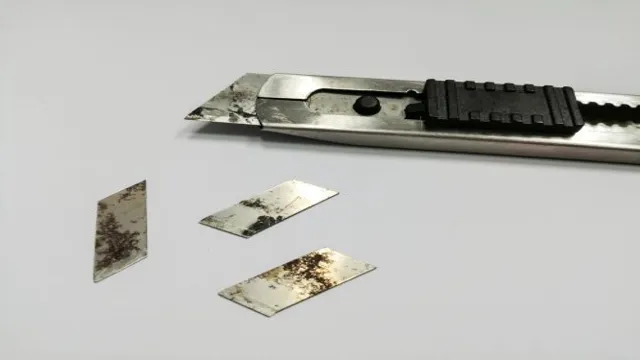
Avoiding Environmental Harm
When it comes to disposing of old utility knife blades, many people simply toss them in the garbage without giving it a second thought. However, this can have negative consequences for the environment. Utility knife blades, like many other sharp objects, can cause harm to people and animals if they are not disposed of properly.
They can also damage the blades of garbage trucks and other equipment, leading to costly repairs. By taking the time to dispose of your utility knife blades safely, you can avoid these negative outcomes. So, what is the best way to dispose of utility knife blades? One option is to use a specialized blade disposal container.
These containers are designed to safely store used blades until they can be disposed of properly. Another option is to wrap the blades in thick tape before throwing them away in the garbage. This helps to prevent injuries to people and animals, and also protects garbage trucks and other equipment from damage.
By taking a few extra steps to dispose of your utility knife blades safely, you can help to protect the environment and prevent accidents and injuries.
How to Safely Dispose of Utility Knife Blades
When it comes to disposing of utility knife blades, safety should be your top priority. Utility knife blades can be dangerous if they are not disposed of properly, so it’s important to know the appropriate steps to take. The first thing you should do is check with your local waste management facility to see if they accept used blades.
If they do, make sure to follow their guidelines for safe disposal. If they do not accept used blades, you can purchase a blade disposal container specifically designed for this purpose. These containers have a slot in the top where you can insert used blades, and they are typically made of heavy-duty plastic to prevent accidental cuts.
Once the container is full, it can be sealed and safely disposed of in the trash. Remember, never throw used utility knife blades directly into the trash where they can easily harm someone. By following these simple steps, you can safely dispose of your used blades and ensure the safety of yourself and others.
Wrap Blades in Material
Utility Knife Blades If you’re wondering how to safely dispose of utility knife blades, wrapping them in material is a great way to do it. Simply wrap the blade with paper, cloth, or any other material to keep it from causing injury or damage. You could also put the blades in a container to keep them from scattering around.
Remember not to throw the wrapped blades in regular trash, as they can still be dangerous and potentially injure someone. Look for specialized bins at hardware stores or take them to a recycling center that accepts sharp objects. This is an effective way to keep yourself and others safe while disposing of your utility knife blades.
Place Blades in a Container
Utility Knife Blades Using a utility knife can be a part of daily tasks, but something that is commonly overlooked is how to dispose of the blades properly. Simply throwing blades into the garbage bin or recycling can be incredibly dangerous for sanitation workers or even pets. Instead, it’s best to place utility knife blades in a container or a special blade disposal unit.
You can purchase a container specifically designed for blade disposal at most hardware stores. When the container is full, it should be sealed tightly and then marked as “sharp objects” to prevent accidents. Proper disposal methods can help keep everyone safe, making for a better tomorrow.
Take Blades to a Recycling Center
If you’re a DIY enthusiast, maintaining your tools is essential for their longevity, safety, and general usability. Utility knife blades, in particular, require careful handling and disposal to prevent accidents and environmental pollution. Instead of tossing them in the trash or recycling bin, which could harm sanitation workers or cause injury at the landfill, you should take them to a recycling center.
Most recycling centers accept utility knife blades, but you should call to confirm if they have specific requirements or restrictions. By recycling your utility knife blades, you are not only making your workspace safer and more efficient but also contributing to sustainability efforts. So, the next time you change a blade, collect them in a designated container and take them to the recycling center.
Your blades will find a new life as raw materials for other products.
Alternatives to Disposing of Utility Knife Blades
When it comes to disposing of utility knife blades, it’s important to do so safely to avoid injury to yourself or others. One alternative to simply throwing them away is to purchase a blade bank, which is a small container specifically designed to safely collect and store used blades. Once the blade bank is full, it can be disposed of in your regular household trash.
Another option is to reuse the blades for other tasks, such as cutting cardboard or opening packages. However, it’s important to note that reusing blades can be dangerous if they become dull or damaged, so always take caution and replace the blade when necessary. Finally, consider contacting your local waste disposal facility to see if they offer blade recycling programs or special collection services.
By properly disposing of your utility knife blades, you can ensure your safety and do your part in protecting the environment.
Sharpen Blades Instead of Replacing Them
Utility knife blades are essential for DIY projects, but constantly replacing them can be a hassle and can add up in expenses. A great alternative to disposing of utility knife blades is to sharpen them. Sharpening your blades not only saves you money but is also environmentally friendly.
A dull blade can cause more harm than good as it can slip and cause accidents. Therefore, it is important to maintain a sharp edge to ensure safety. There are various ways to sharpen blades, depending on the type of blade you have.
You can sharpen blades using a whetstone, sandpaper or a knife sharpener. When sharpening, ensure you maintain the angle of the blade and use gentle pressure. Remember to frequently check the progress to avoid over sharpening the blade.
When it reaches a point where it can no longer be sharpened, dispose of it in a safe manner. By sharpening your blades instead of disposing of them, you not only save money and time but also reduce waste and protect the environment.
Use a Blade Bank or Dispenser
One of the most eco-friendly and cost-effective ways to dispose of utility knife blades is by using a blade bank or dispenser. These handy devices are designed to collect all your used blades in one central location, making it easy to dispose of them safely and responsibly. Blade banks typically come with a slot that you can insert your blades into, while dispensers are equipped with a mechanism that allows you to safely eject blades from the device without risking injury.
Not only do blade banks and dispensers help to keep your workspace tidy, but they also reduce the risk of accidentally disposing of blades in a way that is unsafe for the environment or others. So if you’re looking for an alternative to simply throwing away old utility knife blades, consider investing in a blade bank or dispenser. It’s a small investment that can go a long way in promoting a safer and more eco-friendly work environment.
Conclusion and Final Thoughts
In conclusion, properly disposing of utility knife blades is essential for both safety and environmental reasons. Rather than clumsily throwing them in the trash or recycling, taking the time to place them in a designated blade disposal container or wrapping them securely can ensure the wellbeing of everyone involved. Ultimately, disposing of blades with care can be the sharp solution to a potentially hazardous problem.
“
FAQs
What is the proper way to dispose of used utility knife blades?
Used utility knife blades should be placed in a puncture-resistant container, such as a metal can or plastic bottle, and labeled as “sharps” before being disposed of in accordance with your local regulations. Do not throw them in the regular trash or recycling bin.
Can utility knife blades be recycled?
It depends on your local recycling program. Some programs accept metal blades with other metal recycling, while others do not. Check with your local recycling center to see if they accept utility knife blades.
How do I know when it’s time to replace my utility knife blade?
It is time to replace your utility knife blade when it starts to feel dull or if it is chipped or bent. A dull blade can be dangerous to use as it requires more force to cut, increasing the risk of slipping and injuring yourself.
How often should I change my utility knife blade?
It depends on how often you use it and what you are cutting. As a general rule, it is recommended to change your blade every few weeks, or at least once a month with regular use. However, you should change it immediately if it becomes dull, chipped, or bent.
Can I sharpen my utility knife blade myself?
Yes, you can sharpen your utility knife blade yourself with a sharpening stone or a honing rod. However, it requires some skill and patience to get it right, and it may be more cost-effective to replace the blade if it is too far gone.
What are some safety tips when using a utility knife?
Always cut away from your body and keep your fingers away from the blade. Only use a knife that is sharp, and never try to catch a falling knife. Store it in a safe place, and keep it out of reach of children.
What are some common uses for utility knives?
Utility knives are versatile tools that can be used for cutting a variety of materials, such as cardboard, carpet, rope, and plastic. They are commonly used in construction, woodworking, and other trades, as well as in the home for DIY projects.
